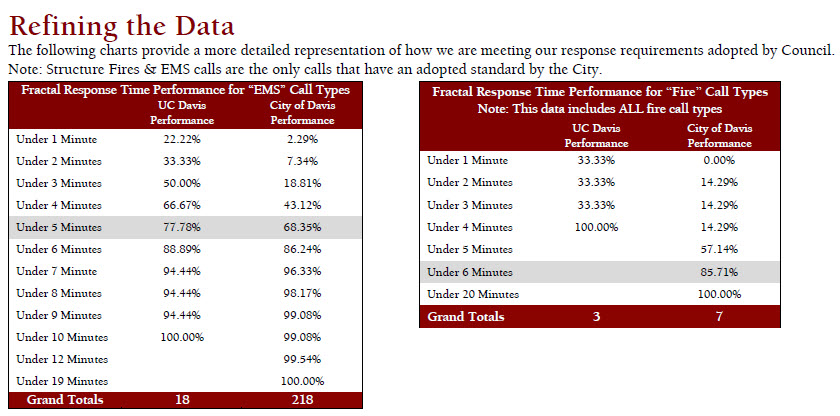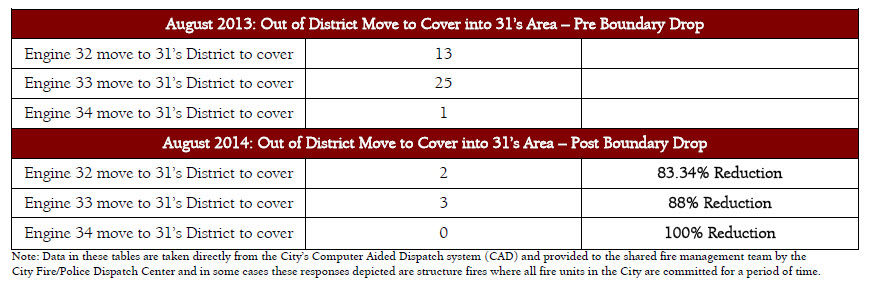
Last year the city of Davis implemented several reforms with the way the fire service provided service to the community. These included modifications to the response times, to put them in line with other community and professional standards, as well as existing response patterns; boundary drop to allow Davis and UC Davis to be first responder regardless of which jurisdiction the emergency was in; fire staffing changes coupled with changes to deployment; and shared services.
The August report shows that these efforts continue to show improvement in the service provided to the community. This has been despite some challenges, mainly due to the weather.
“The month of August was busy for both agencies with respect to out of county strike teams in support of the state’s mutual aid system,” wrote Fire Chief Nathan Trauernicht who heads up both the Davis and UC Davis Fire Departments. “Many of our firefighters have spent a great deal of time deployed over these hot, dry, summer months.”
He continued, “So far, 2014 is shaping up to be one of the most challenging fire seasons of the past few decades. Our firefighters will be entrenched on the front lines of these massive conflagrations through October or until the state receives some significant rain.”
“When a firefighter responds to a large campaign fire common conditions can include: working 24 hour shifts on the fire line, average of 7 to 14 day deployments, rugged terrain, heat and smoke filled conditions, limited sleep and rest periods, limited communications with loved ones, and working in dangerous unfamiliar territory,” he continued.
He added, “While these firefighters are away fulfilling their duties other firefighters are required to cover their time in the City of Davis and UC Davis fire stations to ensure our local communities continue to receive quality service. The amount of time away from home can be taxing on families and loved ones. Many family events are missed in order to fulfill the duty for which these men and women took an oath to perform.”
Despite these challenges, the data put out in monthly reports to the community, continue to show progress.
Types of Calls for Service
As the Vanguard consistently has reported, the vast majority of calls for service are emergency medical, with only 24 of the 388 calls being fire related.
As Chief Trauernicht notes, “Keep in mind that these only depict a single month and that call type, just like volume, changes based on factors heavily influenced by time of year. An example in the City is an increase in Fire – Wildland/Grass during warm weather months, as that includes grass/vegetation fires.”
Response Times
The data on response times, for calls into Davis, continue to show that nearly 90 percent of all calls have a response time of six minutes or less. Structure Fires & EMS calls are the only calls that have an adopted standard by the City. 85% of fire calls are responded to within six minutes of the call while 68% of EMS calls are responded to within five minutes.
Response Readiness
For the purposes of this report, “response readiness refers to a fire company being in its home station, or home district, and ready for a call.”
“Why is this important?” the chief asks. “Simply put, if a fire company is out of district (out of position), response times increase to that response area.”
When the city reduced the number of firefighters on an engine from 4 to 3, it decoupled the rescue apparatus at Rescue 31 from the fire engine, allowing each to respond independently as needed. The logic there was to reduce the number of times a fire engine from one of the peripheral stations had to move up to the central station to cover for Station 31.
Writes Chief Trauernicht, “As you can see below, the focus of our analysis is on the response district of City of Davis Fire Station 31. Why do we call this out? Because this district has the highest call volume and the highest number of stacked calls (also known as simultaneous calls).”
“So when we show a ‘reduction’ in the 2014 month-to-month comparisons, we are basically showing the amount of responses in which Engine 32 and 33 are now remaining in their home districts, when in the past they would have been out of position and response time to those districts would have been extended,” he continues.
He continues, “The chart below represents move ups to cover 31’s station and district when Engine 31 is not available. The first table shows August of 2013, before the boundary drop. The second table shows August of 2014 following the boundary drop.”
“Whenever an apparatus is called to cover another station or district it vacates its first due district to do so,” he continues. “You can clearly see the impact of Engine 34’s role now that the boundary has been dropped in the amount of times that 32 and 33 now stay in their districts ready to provide service to those portions of the community.”
Conclusion
The bottom line is that the data continue to show that the boundary drop and decoupling the rescue apparatus have produced better service overall to the community by allowing the fire engines to stay in their main areas, and reducing the times when they have to move an engine to the central fire station thus leaving their main area uncovered.
—David M. Greenwald reporting








this is going to be a huge war in the coming weeks. bobby has been gathering his forces, he has his city manager, now they’ll push the city and dan wolk to dissolve the shared management agreement and install paul swanson as chief – someone bobby knows he can control. just you watch.
OK, I’ll take the bait. I’ll respond to this deliberate, provocative, and confident prediction of this future Armageddon.
It ain’t going to happen. Were I a betting man, DP, I’d give you thousand to one odds, with no table limit.
Yes, we will watch, promise. Give us a deadline other than a “few weeks,” and we’ll call the question. I’ll put it on my calendar.
Should your call be found to be totally baseless, I ask this for payment. With your anonymity totally preserved, you will post a comment of acknowledged error, judgment, and contrition. I, in turn, will do the same, under my real name, should your prediction come true. Shall we start the clock now?
I agree, “it aint gonna’ happen”! The city has come too far; the new shared fire dept arrangement is working extremely well; City Council members know to turn back now on a successful program would cause huge citizen backlash, the new city manager is just not that stupid, etc.
Let me just foreshadow some upcoming articles by stating that things are far more complex than you have described.
I’ll take Phil Coleman’s assessment as being more accurate than any “foreshadowing” you may think you have. Only time will tell.
DP
i sincerely hope that you are wrong in this regard. I feel that Nate Trauernichr has demonstrated transparency, willingness to interact with the community in an open and honest manner, engagement on the county level with the Health Council and has proven to be an excellent lead for both UCD and the City of Davis Fire departments.
My comment should not be interpreted as any reflection on Mr.Swanson about whom I know nothing, but rather as someone who has had interactions with our current chief and know him to be evidence driven, open to the ideas of others and constantly seeking improvement rather than self promotion.
Thank you for the kind words of support Tia. As always I am humbled and appreciative!
“i sincerely hope that you are wrong in this regard. I feel that Nate Trauernichr has demonstrated transparency, willingness to interact with the community in an open and honest manner, engagement on the county level with the Health Council and has proven to be an excellent lead for both UCD and the City of Davis Fire departments.”
Well said!
Setting aside any speculation of how the politics will play out, I do have a question for Chief Trauernicht about the Response Times tables. Specifically, for all the approximately 40 EMS calls with response times between Under 7 minutes and Under 22 minutes, what was the arrival time of the AMR Ambulance on the scene?
I ask that question because an Under x minutes EMS Call where an ambulance arrives prior to x minutes is a lot less problematic/concerning than one where the ambulance arrives after x minutes.
Matt,
Great question!
I can tell you that anecdotally we are their faster the majority of the time.
We do track AMR response times and I’d be happy to provide a comparison and some dialogue in the October report which will be released in about two weeks!
This will be good information to know, Chief Trauernicht. Anecdotally it has been my experience that the fire department more often than not arrives before AMR, depending on where the incident occurs. It is my understanding that this is because there is only one AMR station; versus 3 fire stations in Davis. Please correct me if I am misinformed. And many thanks for your outstanding service to our community.
Anon,
You are correct, most of the time there is only one AMR unit in the City. They do add another unit occasionally based on need using their statistical data.
It would be very helpful if we saw a monthly report from the Fire Department like this one.
For that matter, when was the last time the Fire department issued a report like this?